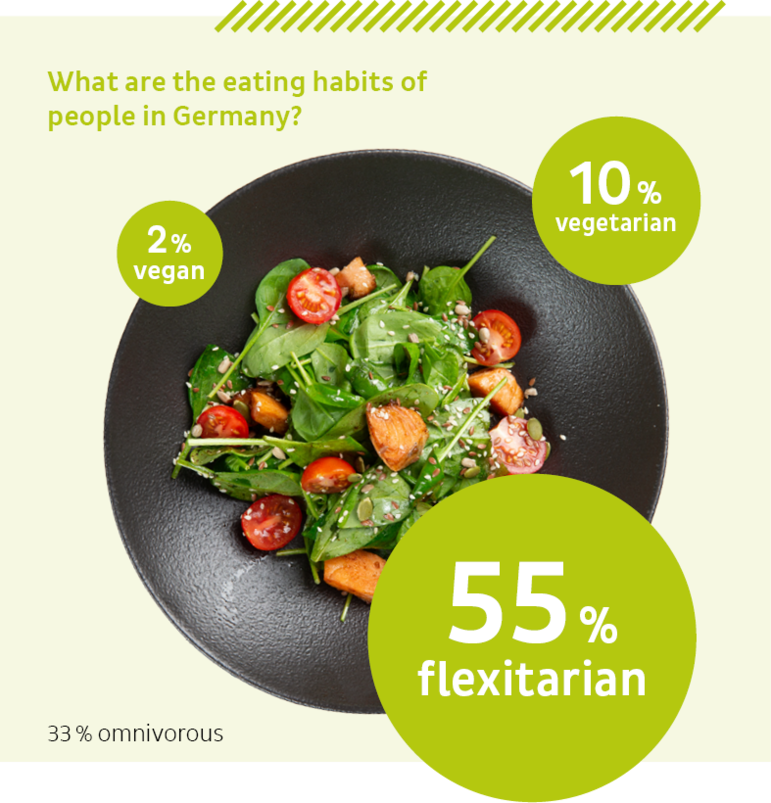
Trends & innovation in catering
Delicious. Sustainable. Innovative.
From company canteens to school and hospital cafeterias, catering plays a crucial role in many people’s diets. Expressed in numbers, we’re talking about an estimated 16 million people a day in this country according to business journal gvPraxis.
Especially in Germany, this is a dynamic sector that is ever evolving to meet consumers’ changing needs and expectations. Sustainability, the shift toward climate-friendly nutrition, and the digital transformation are important factors here, as are the ongoing ramifications of the coronavirus pandemic.
Read on for a look at the three major trends shaping the catering of tomorrow, what challenges emerge for the companies and institutions that operate these kinds of facilities, and how exciting innovations and capable partners can help identify solutions.

Trend #1: Sustainability becomes part of the corporate culture
Sustainability is becoming an increasingly important factor in catering, with all its different facets. Environmentally conscious dietary preferences, reducing waste volumes, and a meal’s carbon footprint are all garnering increasing attention from food service operators and diners.
A 2023 Nestlé study titled “So nachhaltig is(s)t Kantine und Mensa” on sustainability in catering settings also indicates that local foods and products are growing in popularity. When it comes to sustainability, cafeterias and canteens are benefiting from greater transparency along the value chain and from smaller carbon footprints due to shorter supply chains.
A long list of challenges
But as with any coin, the megatrend of sustainability has a flip side as well. Implementing a sustainable menu is a financial challenge for many operating companies and institutions. Humanely sourced local or organic animal products are generally significantly more expensive, and right now these items are also in short supply, as the Nestlé study highlights.
For example, organic farming requires more space than conventional agriculture. At the same time, rising food costs cannot simply be passed along to consumers.
Another challenge lies in reducing or, ideally, entirely eliminating waste volumes. Many cafeteria and canteen managers would like to do away with plastic packaging, for example. And suppliers definitely do need to accommodate that desire in order to meet the standards of their clients and diners.
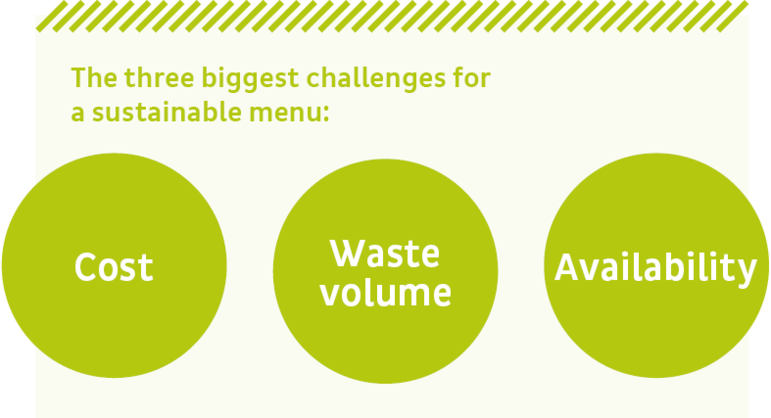
Catering providers also have a responsibility to offer forward-looking concepts to reduce food waste. The DFB Campus in Frankfurt am Main offers an excellent example of how “leaf to root” can be implemented: Dussmann Food Services has managed to almost entirely eliminate food waste in the vegetable segment here. For example, vegetable scraps are an excellent stock base.
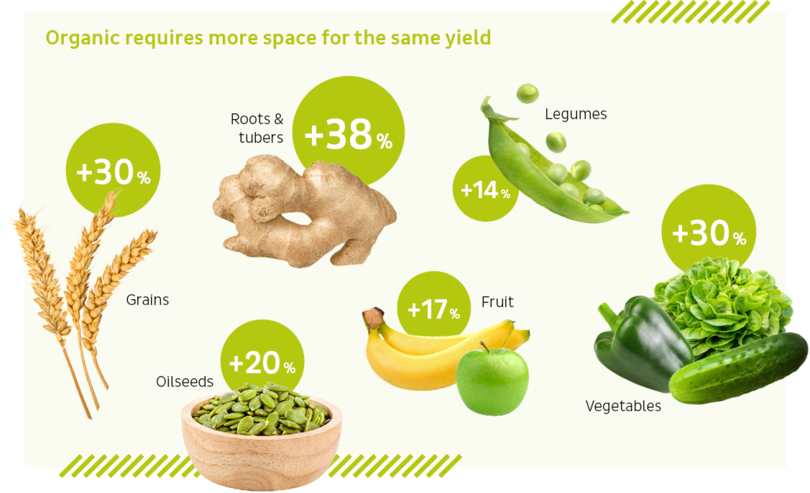

Trend #2: New eating habits
With environmental consciousness and awareness of sustainability on the rise, plant-based foods are coming more and more to the fore, and demand for vegan or vegetarian dishes is also increasing in catering settings. While one veggie day per week used to be a selling point, that is more of a minimum requirement these days.
From vegan and vegetarian to flexitarian, more and more people in Germany prefer a plant-based diet. According to the Nestlé study, about 90 percent of canteens and cafeterias now offer a daily vegetarian option. The majority of operators agree that consumption of vegan and vegetarian dishes is expected to continue to rise, while fish, meat, and poultry are less and less central to people’s eating habits.
With these new eating habits, many diners are already unconsciously aligned with the planetary health diet. This diet is a scientifically founded nutrition plan with two goals: promoting human health, and at the same time reducing impact on the planet.
New eating habits = new challenges
This means kitchen teams need to adjust menus and offer a broader selection of vegan and vegetarian options. But that’s exactly where the challenge lies: Preparing these kinds of dishes requires significantly more time and is more labor-intensive. Extensive knowledge of the foods involved is also needed in order to make these meals fresh, tasty, and varied all at once. At the same time, they need to be easy to scale to the serving needs of large institutions while offering flexibility for people with food allergies or intolerances.
Consumption of vegan and vegetarian dishes is expected to continue to rise, while fish, meat, and poultry are less and less central to people’s eating habits.
It is also important to maintain balance between a modern nutritional plan and time-honored classics. After all, even though an increasing number of guests favor purely plant-based meals, currywurst, meat patties, and meatballs remain popular.
Dussmann founded a startup, the Food Service Innovation Lab, in Berlin to develop just these kinds of foods in 2021. The lab is rethinking and shaping the future of catering. The Food Service Innovation Lab creates recipes aligned with the rules of the planetary health diet, using plant-based alternatives. Before these foods are rolled out in catering settings, they are served at Europe’s first PLANET!BASED restaurant, Ursprung, which is located in the Dussmann Building. This means Dussmann clients can rest assured that they will be able to offer tested, scalable meals. Worries of having to “eat” the cost of unpopular vegetarian versions are now a thing of the past.
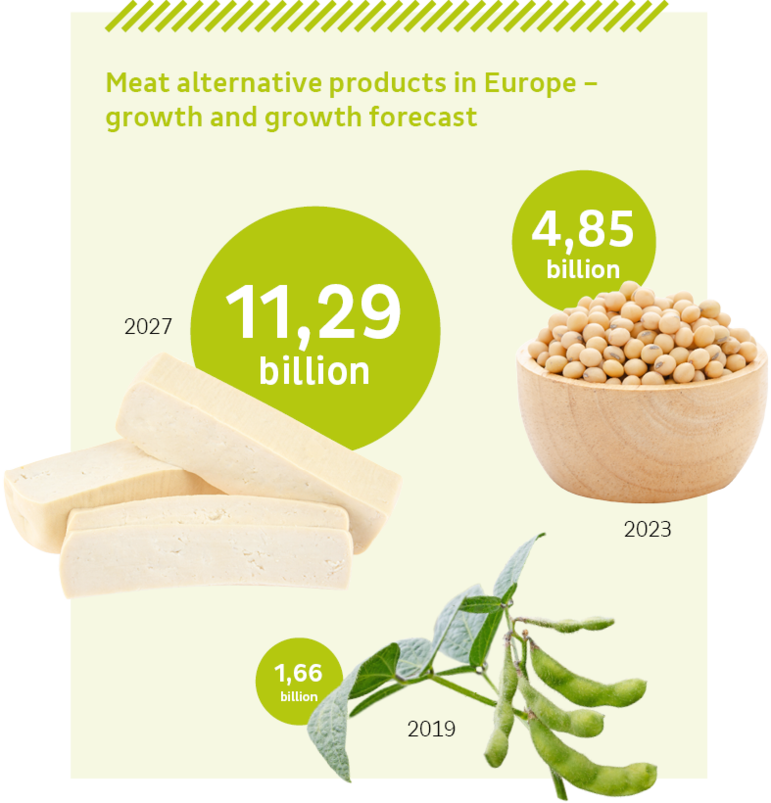

Trend #3: Hybrid dining solutions
But eating habits aren’t the only thing to have changed since the pandemic. In the post-COVID-19 era, New Work is reshaping not only the way we work, but also how people eat. Everyday life is no longer structured around mealtimes. Instead, dining habits have adapted to changes in working hours and flexible workplace models. As a result, employee restaurants see sharp fluctuations in capacity utilization during a given week, with fewer diners on Mondays and Fridays, but up to 90 percent capacity utilization the rest of the week.
One thing is clear: Companies with large office workforces in particular need to adjust to flexible guest behavior and offer new dining solutions. One potential solution for these changing structures is the use of hybrid models such as smart vending machines or refrigerators containing attractive snacks. Real-world experience shows that employees often order multiple servings and take some home to work remotely the next day.
Hybrid – that’s all well and good. But how?
Companies and institutions face serious financial challenges in implementing modern dining solutions. For example, procuring the appropriate appliances and equipment requires careful planning and budgeting, since in addition to the purchase price, there are also ongoing costs of maintaining and stocking the machines. However, these investments can be tremendously worthwhile as a result of savings on food waste – going easy on the wallet and the environment at the same time.
In addition, organizations also have to inform both canteen and cafeteria workers and diners about the new dining options. Smart vending machines offering pre-cooked ready-to-eat foods or smart refrigerators containing seasonal snacks are only a seamless addition to operations if these devices are used properly.
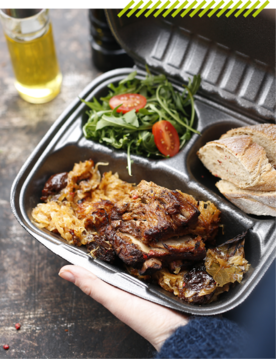
Aside from organizational matters, it is also important to recall that stringent hygiene standards must be upheld, especially when it comes to self-service foods. Food safety and quality must be ensured at all times to minimize potential health risks. Regular cleaning and disinfection of smart vending machines and fridges requires careful handling.
Dussmann also scores points for waste reduction by using reusable dishes in smart vending machines. Multiple Dussmann corporate restaurants are already using these reusable solutions. Dussmann also partners closely with reusable provider Vytal. This approach lets guests consume their dishes worry-free and simply return the containers at the vending machine within two weeks.
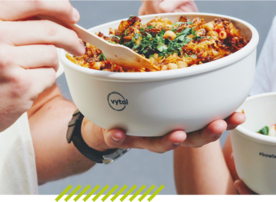
Conclusion
The catering sector is currently experiencing sweeping change. In addition to a traditional meal of currywurst at noon on the dot, canteen and cafeteria concepts that involve flexible breaks, a broad selection of vegan and vegetarian dishes, and local foods are required. The focus is on foods that benefit both people and the planet. At the same time, it is important to meet people where they are with their current dining habits instead of scolding or lecturing. From traditional to modern, that means the focus should always be on guests’ preferences, needs, and requirements – which are exactly what Dussmann Food Services uses as individual guidance.
Feel free to contact us!
Want to learn more about trends and innovation in catering? Need advice? We’re here to help.
